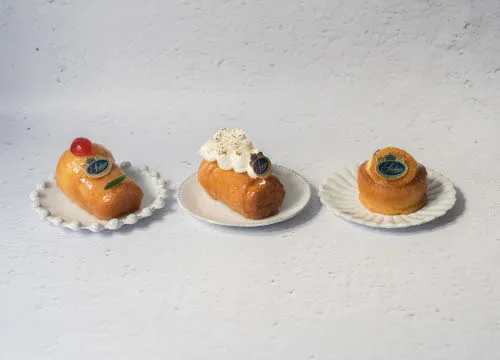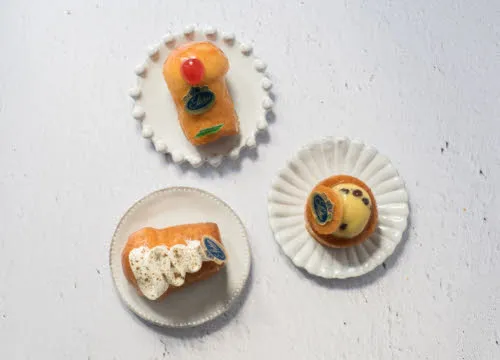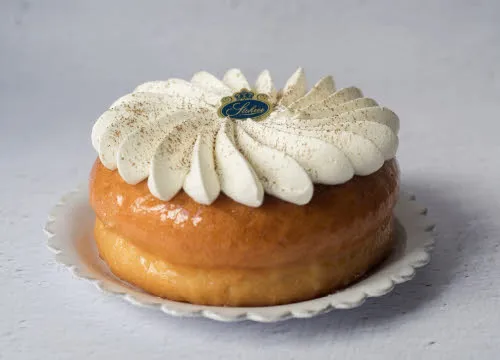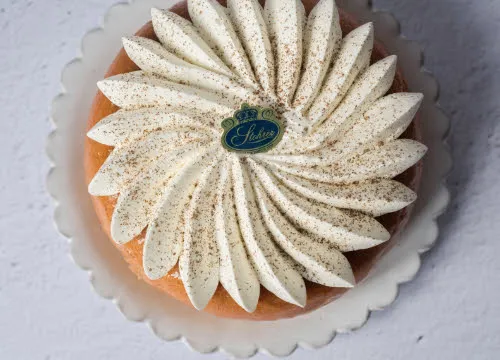Published:
Author: Antonio Maria Guerra
Neapolitan Rum Babà

Probably not everyone knows that the origins of Rum Baba, the famous Neapolitan dessert, are linked to a region located in the North-East of France, Lorraine, and to a Polish king, Stanisław Leszczyński. Let’s find out the fascinating history of this delicacy, its secrets and many curiosities, with the precious help of the most traditional French and Italian pastry shops making Babà still today.

The history of Rum Baba.
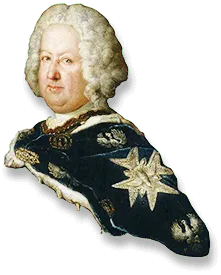 The birth of the Babà dates back to the first half of the eighteenth century and is generally associated with the Polish king Stanisław Leszczyński. This monarch, in addition to being a refined intellectual, had a great passion for food and wine: a passion that he was able to cultivate during his golden exile at Lunéville in Lorraine (*1). Many sources claim that it was he who invented the famous dessert (*2), wetting a very famous cake from Central Europe, the Kugelhopf (*4), with wine (*3), to make it softer (*5) . Despite this, it would seem that, in truth, the author of this addition was his personal pastry chef: Nicholas Stohrer.
The birth of the Babà dates back to the first half of the eighteenth century and is generally associated with the Polish king Stanisław Leszczyński. This monarch, in addition to being a refined intellectual, had a great passion for food and wine: a passion that he was able to cultivate during his golden exile at Lunéville in Lorraine (*1). Many sources claim that it was he who invented the famous dessert (*2), wetting a very famous cake from Central Europe, the Kugelhopf (*4), with wine (*3), to make it softer (*5) . Despite this, it would seem that, in truth, the author of this addition was his personal pastry chef: Nicholas Stohrer.
However, it should be emphasized that the Babà, in its primitive form, differed quite a lot from what we know today, starting with the name, which initially was ‘Alì Babà’ (6*), without neglecting the fact that its dough, unlike the one we know today, was enriched with saffron and raisins.
Read more
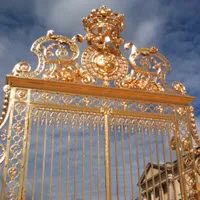 The specialty was very successful when it was served at the palace of Versailles: it was probably Stohrer himself who prepared it. He had followed Marie Leszczyńska, daughter of Stanisław, who was married to King Louis XV. Shortly after, the dessert began to be wet with Rum, taking the name of ‘Baba au Rum’ (‘Rum Babà’) or just ‘Babà’. This should not surprise: the liqueur, coming from the colonies, was at the time all the rage among the French aristocrats. Quite soon, the variations of the dessert became numerous: ‘interpretations’ of the original soaked with different types of liqueur, often accompanied by custard, cream or fruit (*7).
The specialty was very successful when it was served at the palace of Versailles: it was probably Stohrer himself who prepared it. He had followed Marie Leszczyńska, daughter of Stanisław, who was married to King Louis XV. Shortly after, the dessert began to be wet with Rum, taking the name of ‘Baba au Rum’ (‘Rum Babà’) or just ‘Babà’. This should not surprise: the liqueur, coming from the colonies, was at the time all the rage among the French aristocrats. Quite soon, the variations of the dessert became numerous: ‘interpretations’ of the original soaked with different types of liqueur, often accompanied by custard, cream or fruit (*7).
Notes:
*1: Region located in northeastern France;
*2: According to a legend, quoted by many sources as historical evidence, the king wet the Kugelhopf accidentally, in a moment of irritation. Given Leszczyński’s value as a gourmet, it is far more likely (in case) that the modification to the original recipe was intentional;
*3: It was probably Malaga wine, although experiments with Madeira, Tokaj and different types of syrup cannot be excluded;
*4: The Kugelhupf (or ‘Gugelhupf’) is an Austrian sweet specialty: there are many variations of it, with different names, in many European countries. Among them Poland, birthplace of Stanisław Leszczyński, where, coincidentally, it’s known by the name ‘Babka Ponczowa’;
*5: According to some sources, Stanisław Leszczyński suffered from chewing problems and this forced him to find a way to soften the dessert;
*6: It seems that King Stanisław loved the novel ‘Ali Babà and the forty thieves’ so much that he used the name of its main character to baptize the dessert;
*7: The most famous of them was certainly the Babà ‘Savarin’;


Neapolitan Rum Babà
THE MOST TRADITIONAL PASTRY SHOPS
This article is the result of the collaboration between WebFoodCulture, Pasticceria Scaturchio and Pasticceria Stohrer.

Naples, the city of Rum Baba.
Naples, the ‘city of the sun’, is the county seat of Campania region. Its origins date back to the 8th Century BC.

The arrival of Rum Baba in Naples.
It was the ‘monsù’, the cooks of the aristocratic families (*1), who introduced the Babà in southern Italy during the first half of the nineteenth century. The dessert was much appreciated in Naples, a city that has always been close to France (*2): here it found a second home, undergoing a further evolution compared to the French version.
Read more
The changes were related mainly to the dough, made even lighter thanks to a triple leavening, and to the composition of the ‘bagna’ (the ‘wetting’), the liqueur compound used, as for its name, to wet (in Italian ‘bagnare’) the specialty.
The small size of the ‘mushroom’ shaped Babà, soon made of it the most classic ‘strolling dessert’, all the rage among the Neapolitan elite (‘Napoli bene’).
Notes:
*1: The nickname ‘monsù’ indicated the cooks working for the aristocratic families and was the Italianization of the French word ‘monsieur’: that’s because these cooks were sent to France (at the time considered the undisputed reference point for fashion and food) to attend specialization courses;
*2: In this regard, it’s important to remember that, thanks to Maria Carolina of Austria, sister of the famous Marie Antoinette and wife of Ferdinand IV of Bourbon, many French specialties became very popular among the Neapolitan nobility. Specialties such as Béchamel and Gâteau (‘Gattò’);

The name 'Babà'.
Not everyone knows that the ‘Baba’ was originally known as ‘Alì Babà’: this name had been assigned to the dessert by the exiled Polish king Stanisław Leszczyński, a great lover of the fascinating tales of the ‘Thousand and One Nights’. In this regard, it should be noted that the specialty enjoyed by Stanisław was quite different from the one so popular today.
Read more
The sweet delicacy, over time, would undergo an evolution: it was when it began to be wet with Rum that it started to be called ‘Rum Baba’ (‘Baba au rhum’) or just ‘Babà’.
However, it cannot be excluded that the name is somehow related to the one, very similar, of another dessert of Polish origin: the ‘Babka’.
Even today, the oldest Parisian pastry shop, founded in 1730 by the king’s patissier, Nicolas Stohrer, includes the ‘Alì Babà’ in its menu.

Neapolitan Rum Baba: calories and nutritional values.
As always happens, it’s difficult to recommend desserts in a hypocaloric diet. Babà is no exception. The average calorie content in a 100 grams portion can vary, roughly, between 230 Kcals and 260 Kcals. The specialty contains carbohydrates (sugars), fats, salt, and proteins.

Neapolitan Rum Baba: ingredients and preparation.
Here follows the list of the ingredients used in the preparation of Babà dough and its ‘bagna’ (the ‘wetting’):
THE DOUGH:
- Manitoba flour;
- Butter;
- Eggs (including yolk);
- Fresh brewer’s yeast;
- Sugar;
- Salt;
By mixing these ingredients it’s possible to make a dough that, once risen, becomes soft and elastic. This doungh will be then placed in special molds and baked in the oven.
THE ‘BAGNA’:
- Water;
- Sugar;
- Rum;
- Strega liqueur aroma;
- Alchermes liqueur;
The ‘bagna’ (‘wetting’) is the liqueur compound used to wet Babà. Once the dessert is out of the oven and cooled, it’s immersed in this compound (heated) until it’s sufficiently softened.
The preparation of Rum Baba in video.
An interesting video, made by Pasticceria Scaturchio, shows the preparation of Neapolitan rum Babà.

The shape of Rum Baba.
Originally Babà had a circular ‘bell’ shape, which (generally) had a hole in the center and grooves on the sides.
Read more
The famous ‘mushroom’ shape was adopted later: its origins are much debated still today. Some speculate that its invention should be attributed to the pastry chef of King Stanisław, Nicolas Stohrer, others to the Neapolitan pastry school. Despite this, it’s very likely that it was born by chance, as a side effect of the dough leavening during the cooking.

The variants of Rum Baba.
As it often happens, over time variants of the more traditional gastronomic specialties arise. Babà is no exception: nowadays it’s possible to taste it accompanied, for example, by custard, whipped cream or chocolate.
Read more
It may also happen that the dough is modeled in shapes different from the classic ones or that it’s enriched with a filling.
One of the most recent examples of these tasty alternatives is the ‘Babà with Limoncello’, flavored with lemon liqueur and cream: not surprisingly this delicacy is originally from the island of Capri and the Amalfi Coast.

The ‘Babà Savarin’.
One of the most famous and appreciated variations of Babà is certainly the ‘Babà Savarin’ (*1), a dessert invented during the first half of the nineteenth century by the Julien brothers, famous Parisian pastry chefs, who chose its name in honor of the gastronome Jean Anthelme Brillat-Savarin (*2).
Read more
Its dough differs from that of the classic Babà for the presence of milk, an ingredient that makes it lighter and more spongy. The specialty has the shape of a great donut, wet with rum (*3), and brushed with apricot jam.
The center of the donut is filled with a fruit salad that can be garnished in many ways (*4).
Notes:
*1: The name ‘Savarin’ is often (improperly) used to indicate a ‘normal’ Baba in the shape of a donut;
*2: Savarin is the acclaimed author of ‘The physiology of taste’ (‘Physiologie du Goût’): a true reference point for lovers of gastronomic literature;
*3: Other types of liqueur are often used, such as Grand Marnier;
*4: The most popular toppings in the city of Naples are yellow cream and black cherries or whipped cream and wild strawberries;

‘Kugelhopf’, the ancestor of Rum Baba.
‘Kugelhopf’ (or ‘Gugelhupf’) is the name used in many central European countries and especially in Alsace, for a particular type of cake (*1). This dessert can boast a very ancient tradition and is served mainly during the holidays.
Read more
It has a toroidal shape, quite high, which may recall a skirt. It consists of leavened dough, rich in butter, and generally stuffed with raisins. There are many variations of this specialty in other European countries that include other ingredients: among them, for example, the Polish ‘Babka’ and the Czechoslovakian ‘Bábovka’.
Note:
*1: According to many scholars, this dessert could be related to the Italian ‘Pandoro’.


Stanisław I Leszczyński, the king of Babà.
Stanislaus I Leszczyński (1677/1766) was recognized as ruler of Poland in 1704. His reign was very troubled, so much that he was forced into exile twice.
Read more
In 1723 his second child, Maria Leszczyńska, married Louis XV of France. He is remembered as an intellectual, great lover of arts and letters and particularly sensitive to the pleasures of the table: this explains why he is often (and erroneously) credited with the invention of the ‘Alì Babà’, dessert that can be considered the ‘father’ of the Babà.

Nicolas Stohrer and his pastry shop.
In 1730 Nicolas Stohrer, the ‘father’ of Babà, after years of service for King Stanisław I Leszczyński and for his daughter Marie Leszczyńska later, finally opened his patisserie.
Read more
It’s fascinating to find out that, after almost three hundred years, this pastry shop is still in business: it’s the oldest in Paris (*1). Located at 51 Rue Montorgueil, it continues to serve the confectionery specialties invented by the founder (and not just him).
Note:
*1: In 1984 the pastry shop was declared French historical monument.

Scaturchio and Stohrer pastry shops: contacts.
Here follow the contact info of Scaturchio (Naples) and Stohrer (Paris) pastry shops: the custodians of Babà tradition.
Pasticceria Scaturchio
Address: P.zza S. Domenico Maggiore, 19
80134 Napoli
Official website: www.scaturchio.it
Mail: info@scaturchio.it
Tel.: +39 081 551 7031
Pasticceria Stohrer
Address: 51, rue Montorgueil
75002 Parigi – Francia
Official website: www.stohrer.fr
Mail: contact@stohrer.fr
Tel.: +33 1 42 33 38 20
Copyright information.
The images displayed in this page belong to WebFoodCulture, Pasticceria Scaturchio and to Pasticceria Stohrer, with the exception of:
Public Domain Images
- Stanisław Leszczyński, 1731 , Antoine Pesne (Wikipedia Link) {PD-Art} {PD-US}
- Portrait of Stanisław Leszczyński, 1727-1728 Jean-Baptiste van Loo (Wikipedia Link) {PD-Art} {PD-US}
- Stanisław Leszczyński, 1750, painting by Jean Girardet (Wikipedia Link) {PD-Art} {PD-US}
Creative Commons Images
- Babà Savarin, imahe owner: Brandon Daniel (Wikipedia Link)
- Turta kouglof , image owner: Vargenau (Wikipedia Link)

